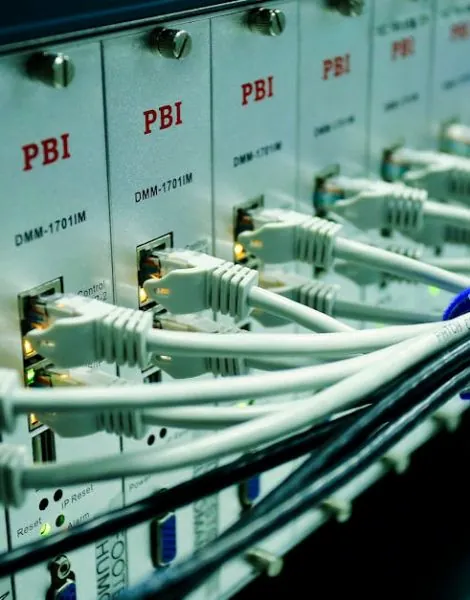In the world of networking, keystone patch cords are the unsung heroes, quietly keeping connections alive while most people are blissfully unaware. These little cables may not have the spotlight, but they’re the backbone of efficient data transfer, making them essential for any tech-savvy setup. Imagine trying to connect your devices without them—it’s like trying to make a sandwich without bread. Good luck with that!
With their versatility and ease of use, keystone patch cords are perfect for both home and office environments. They’re not just cables; they’re your ticket to a seamless network experience. So, whether you’re a casual user or a networking guru, understanding the ins and outs of these cords can save you from a tangled mess of frustration. Let’s dive into the fascinating world of keystone patch cords and see why they deserve a prime spot in your tech toolkit.
Table of Contents
ToggleOverview of Keystone Patch Cords
Keystone patch cords play a vital role in enhancing networking efficiency. They are often integral in both residential and commercial environments.
Definition and Purpose
A keystone patch cord consists of a flexible cable with male connectors on both ends, designed for quick connections in networking systems. Its primary purpose involves linking various devices, such as computers, routers, and switches. By enabling data signal transmission, these cords help optimize network performance and ensure seamless communication. In addition, the convenience of quick disconnecting and reconnecting contributes to their popularity.
Types of Keystone Patch Cords
Several types of keystone patch cords exist, catering to different networking needs. Category 5e cords serve well for standard Ethernet connections, accommodating speeds up to 1 Gbps. Category 6 patch cords offer enhanced performance, supporting data rates of up to 10 Gbps over shorter distances. Fiber optic keystone patch cords provide superior speed and bandwidth, ideal for high-demand applications. Each type of cord varies in specifications, making it essential to choose the right one based on specific requirements.
Benefits of Using Keystone Patch Cords
Keystone patch cords offer several advantages that improve networking setups significantly.
Improved Cable Management
Effective cable management remains a crucial aspect of any networking environment. Keystone patch cords simplify organization by reducing clutter. Flexible designs allow for easier routing around corners and obstacles, keeping pathways clear. The modular nature permits users to select the exact length required, helping eliminate excess cable. With the right tools, it’s easy to create a neat and tidy workspace. Labeled cords ensure quick identification, which speeds up troubleshooting and maintenance efforts.
Enhanced Network Performance
Enhanced network performance results from utilizing keystone patch cords. These cords support high-speed data transfer, crucial for modern applications. By selecting the appropriate category, users can optimize transmission speeds to meet their specific needs. Category 6 cords, for instance, support up to 10 Gbps over shorter distances, making them ideal for high-demand environments. Fiber optic options provide even greater bandwidth, addressing the requirements of data-heavy operations. Users experience fewer interruptions and improved connectivity as a result.
Key Features to Consider
Understanding key features aids in selecting the right keystone patch cords for optimal performance.
Cable Length and Flexibility
Cable length significantly impacts performance and usability. Determining the appropriate length prevents excess slack, which can cause tangling and clutter. Keystone patch cords typically range from one foot to 50 feet, with customized lengths available. Choosing flexible cords enhances ease of use in tight spaces and allows for easier cable management. Users can connect devices without worrying about cable strain or interference. Make sure to assess specific installation requirements to ensure the right fit for your network setup.
Connector Types
Connector types play a crucial role in ensuring compatibility with networking equipment. Common types include RJ45 connectors for Ethernet connections, SC connectors for fiber optics, and LC connectors for high-density applications. Each connector type serves different purposes, so understanding the device requirements is vital. Choosing the right connector guarantees reliable data transfer and minimizes signal loss. Users benefit from selecting patch cords that match their equipment, thus achieving seamless communication and enhanced network performance.
Comparison with Other Patch Cords
Keystone patch cords stand out when compared to other types of patch cords. Their modular design offers flexibility not found in standard patch cords. Unlike standard patch cords, which typically come in fixed lengths, keystone patch cords allow users to select lengths tailored to specific needs. This versatility reduces clutter and enhances cable management. Additionally, keystone patch cords utilize connectors that easily snap into keystone wall plates or panels, providing a clean and organized appearance in both home and office settings.
Keystone Patch Cords vs. Standard Patch Cords
Keystone patch cords differ significantly from standard patch cords. Standard patch cords often feature fixed lengths and lack the modularity that keystone patch cords provide. Flexibility in installation becomes crucial, especially when optimizing workspace organization. Users benefit from the ability to customize lengths with keystone patch cords. Furthermore, keystone cords support quicker connections by integrating seamlessly with existing keystone wall plates. This compatibility enables easier upgrades or swaps of components without disrupting an entire setup.
Keystone Patch Cords vs. Fiber Patch Cords
Comparing keystone patch cords to fiber patch cords reveals distinct differences. Fiber patch cords excel in scenarios requiring high-speed data transmission and greater bandwidth. Keystone patch cords, in contrast, primarily operate in Ethernet environments, catering to typical networking needs. The choice between the two depends on specific requirements; users needing high-frequency performance should opt for fiber. However, those seeking solid performance for everyday applications should consider keystone options. Additionally, installation processes differ, as fiber patch cords demand more careful handling due to fragility compared to the robust construction of keystone patch cords.
Keystone patch cords are indispensable tools in modern networking. Their versatility and ease of use make them suitable for both home and office environments. By selecting the right type and length, users can optimize their network performance while maintaining a tidy workspace.
Investing in quality keystone patch cords leads to fewer interruptions and enhanced connectivity. The modular design allows for tailored solutions that meet specific needs. With the right knowledge, anyone can elevate their networking experience and ensure seamless communication across devices.









